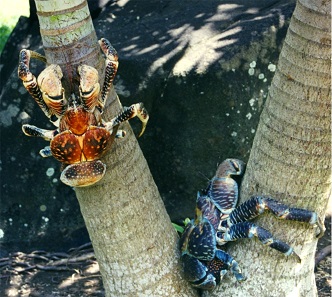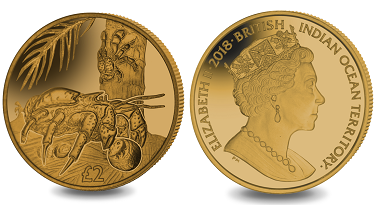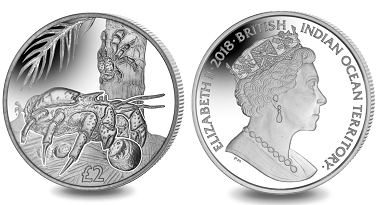February 15, 2018 – A rather unusual heraldic animal is to be found on one of the newest coins issued by the British Pobjoy Mint: The Coconut Crab, the largest land-living crab, represents the British Indian Ocean Territory as it is indigenous to both the Indian and the Pacific Ocean.
Coconut crabs vary in size and coloring. Photo: Brocken Inaglory / CC BY-SA 3.0
The Coconut Crab is the world’s largest Land Arthropod and an incredibly impressive looking crab. These Crabs are widely found in the British Indian Ocean Territory so an issue on the behalf seemed appropriate. The design shows two large coconut crabs, one on the floor feasting on the flesh of a coconut and the other climbing a coconut palm. The denomination shown is £2, available in Titanium and Cupro Nickel.
British Indian Ocean Territory / 2 Pounds / Titanium / 10g / 36.1mm / Mintage: 7,500.
The obverse features the Pobjoy exclusive effigy design of HM Queen Elizabeth II in exceptional detail. As Titanium reacts differently with every strike each of the 7,500 Titanium coins are technically different and vary slightly in colour. There is also a lined effect that is present on the coins which is unique to this metal.
British Indian Ocean Territory / 2 Pounds / Cupro Nickel / 28.28g / 38,6mm / Mintage: 10,000.
Coconut crabs are famous for their massive size, weighing over 4kg and with a leg span that can reach over 1 metre. This makes these crabs the largest land-living Arthropod in the world. They are found throughout Indonesia, Indian Ocean and parts of the Pacific. Although their name suggests that they primarily feed on Coconuts, this is not the case and coconuts make up as small proportion of their diet. They can however be found climbing the Coconut Palms and occasionally using a broken coconut shells as protection. Recent footage has shown a coconut crab hunting a Sea bird! Once they get hold of the bird, their powerful claws easily break the bird’s wings and then more crabs that smell the kill will descend on the defenceless bird!
Unfortunately, Coconut crabs have been extensively hunted on islands where there is a human population as their flesh is considered both a delicacy and an aphrodisiac. When the tables are turned and they manage to pinch a human, they can cause considerable pain and will not release their grip for a long time. One technique used to free someone from their powerful grip is to tickle their underbelly!
More information on the coin is available on the Pobjoy website.
You can watch a coconut crab in this video.







